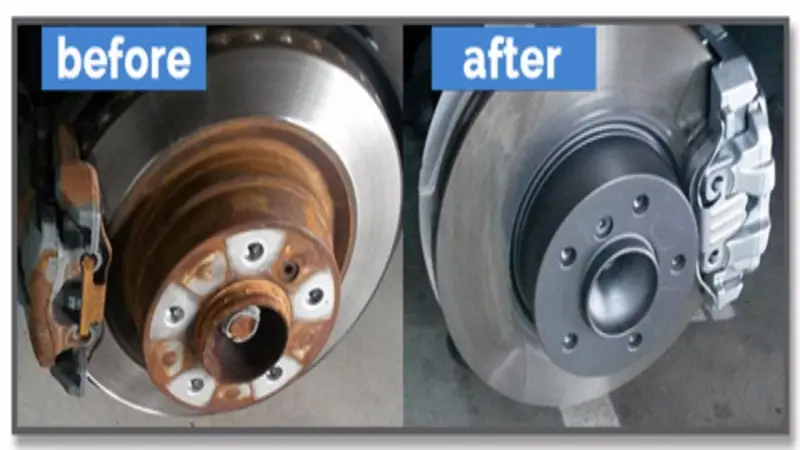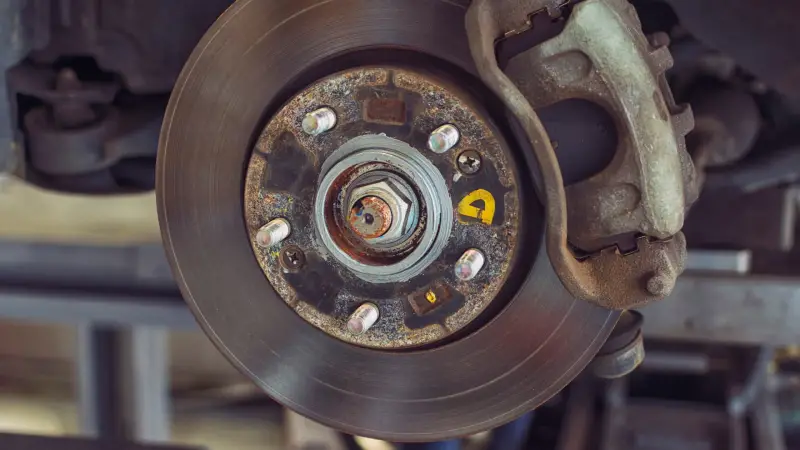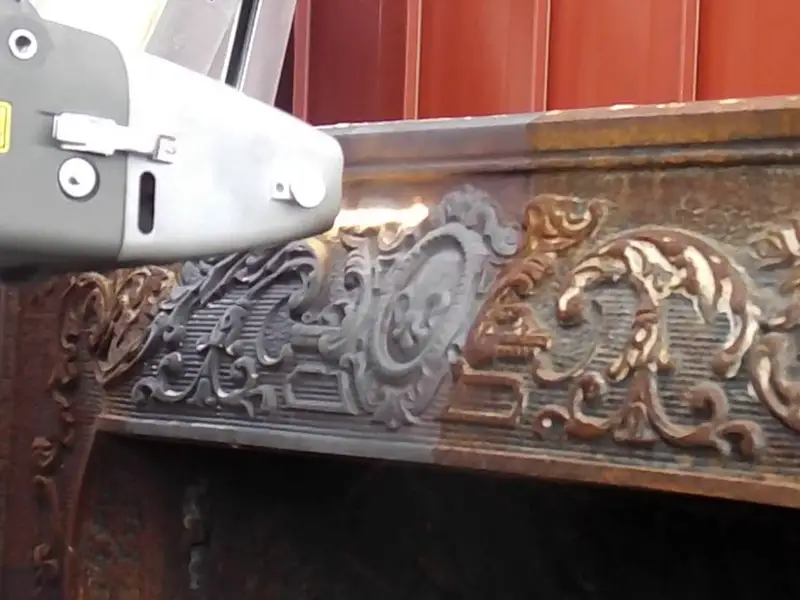Rust on brake rotors can be a frustrating and potentially dangerous issue for car owners. Not only does it look unsightly, but it can also reduce the effectiveness of your brakes and make it more difficult to stop your vehicle when needed. In this blog post, we’ll explore the causes of rust on brake rotors and provide you with step-by-step instructions for removing it effectively.
First, we’ll discuss the different methods for removing rust, including sanding, grinding, and chemical treatments. We’ll examine the pros and cons of each approach and help you determine which one is best for your specific situation. Then, we’ll go through the process of removing rust from brake rotors, from preparing the surface to reassembling the brakes and testing them. Whether you’re a seasoned mechanic or simply looking to do some basic maintenance on your car, this post will give you the information you need to remove rust from your brake rotors and get back on the road safely.
So, are you ready to tackle some rusty brake rotors and get your brakes back in top condition? Let’s get started!
Removing Rust From Brake Rotors Overview
Removing rust from brake rotors is a super satisfying and straightforward process that can give your vehicle a whole new level of performance. Whether you’re a seasoned mechanic or just looking to do some basic maintenance, you’ll be thrilled with the results.
There are several methods for removing rust, including sanding, grinding, and chemical treatments. Each approach has its own pros and cons, but with a little bit of patience and know-how, you’ll be able to get rid of that unsightly rust in no time.
Personally, I’m a big fan of sanding for removing rust from brake rotors. It’s an economical option that provides excellent results with the right sandpaper and a little elbow grease. You’ll need to spend a little bit of time on each rotor, but the payoff is totally worth it. The brake rotors will look as good as new and perform just as well as they did when they were first installed.
Grinding is another option that provides fast results, but it can be a bit noisy and require more specialized equipment. Chemical treatments are also a great choice, especially for those who don’t have access to sandpaper or grinding equipment. Simply apply the solution, let it sit for the recommended time, and rinse it off. It’s that easy!
No matter which method you choose, removing rust from brake rotors is a project that you’ll feel great about completing. Not only will your vehicle look better, but it will also perform better, giving you peace of mind and confidence on the road.
Removing Rust From Brake Rotors – Methods in Comparison
Understanding the Problem
Rust on brake rotors can be caused by a variety of factors, including exposure to moisture, road salt, and brake dust. Over time, this rust can build up and cause issues with the performance of your brakes. It’s important to address rust on your brake rotors as soon as possible to ensure the safety and performance of your vehicle.
Methods for Solving the Problem
- Sanding
Sanding is an economical option for removing rust from brake rotors. It involves using sandpaper to physically remove the rust from the surface of the rotor. Sanding can be done by hand or with a power tool, such as an angle grinder. The key to success with sanding is to use the right sandpaper and to take your time to ensure an even and thorough result.
- Grinding
Grinding is another option for removing rust from brake rotors. It involves using a specialized tool, such as a bench grinder, to physically remove the rust from the surface of the rotor. Grinding is a fast option that can provide excellent results, but it can be noisy and require more specialized equipment.
- Chemical Treatments
Chemical treatments are a great option for those who don’t have access to sandpaper or grinding equipment. Chemical treatments involve applying a solution to the surface of the rotor, letting it sit for a specified period of time, and then rinsing it off. Chemical treatments are a convenient option, but it’s important to follow the manufacturer’s instructions carefully to ensure safe and effective results.
| Method | Pros | Cons |
|---|---|---|
| Sanding | Economical, can be done by hand or with a power tool, provides excellent results | Time-consuming, requires the right sandpaper |
| Grinding | Fast, provides excellent results | Noisy, requires specialized equipment |
| Chemical Treatments | Convenient, safe and effective results | Follow manufacturer’s instructions carefully |
Conclusion
In conclusion, removing rust from brake rotors is a straightforward and rewarding process. There are several methods for removing rust, including sanding, grinding, and chemical treatments. Each approach has its own pros and cons, so it’s important to consider your specific situation and needs before making a decision. Whether you’re a seasoned mechanic or simply looking to do some basic maintenance, this guide will help you get started on removing rust from your brake rotors and restoring the performance and safety of your vehicle.

Equipment To Work With Removing Rust From Brake Rotors
| Equipment | Description |
|---|---|
| Sandpaper | Used for sanding the rust off the surface of the brake rotor. Available in various grits, with higher grits providing finer results. |
| Angle Grinder | A power tool used for sanding the rust off the surface of the brake rotor. Can be fitted with various sanding discs to suit the task at hand. |
| Bench Grinder | A specialized tool used for grinding the rust off the surface of the brake rotor. Can provide fast results, but can be noisy. |
| Chemical Treatment Solution | A specialized solution used to dissolve rust from the surface of the brake rotor. Follow the manufacturer’s instructions carefully for safe and effective results. |
| Gloves | Protective gloves should be worn when working with chemical treatments to protect your skin. |
| Eye Protection | Eye protection should be worn when using power tools to protect your eyes from debris. |
| Rags or Paper Towels | Used for wiping away debris and excess chemical treatment solution. |
Note: Depending on the method you choose for removing rust from your brake rotors, you may not need all of the equipment listed above. Additionally, some equipment may be optional or substituted for similar items you have on hand. The key is to have the equipment and materials you need to complete the task safely and effectively.
Step-by-Step Instruction On Removing Rust From Brake Rotors
- Prepare the work area. Make sure you have all of the equipment you need, including sandpaper, gloves, eye protection, and rags or paper towels. Clear the work area and lay down a protective covering, such as a tarp or drop cloth, to catch any debris.
- Clean the brake rotors. Use a brake cleaner or degreaser to thoroughly clean the surface of the brake rotors. This will help to remove any dirt, dust, or grease that may interfere with the rust removal process. Allow the brake rotors to dry completely.
- Put on gloves and eye protection. Protect your skin and eyes from any chemicals or debris that may be present during the rust removal process.
- Choose your method. Depending on your situation and the tools you have available, you may choose to sand, grind, or treat the brake rotors with a chemical solution. If you’re sanding or grinding, attach the appropriate sanding disc or grinding wheel to your power tool.
- Sand the brake rotors. If you’re sanding the brake rotors, use a moderate and even pressure to work the sandpaper over the surface of the rotor. Use a higher grit sandpaper for a finer finish, and work slowly and methodically to ensure an even result.
- Grind the brake rotors. If you’re grinding the brake rotors, use a moderate and even pressure to work the grinding wheel over the surface of the rotor. Work slowly and methodically to ensure an even result.
- Apply the chemical treatment. If you’re treating the brake rotors with a chemical solution, follow the manufacturer’s instructions carefully. Apply the solution to the surface of the rotor and let it sit for the recommended time. Rinse the brake rotors thoroughly with water to remove the solution.
- Check your work. Once you’ve completed the rust removal process, inspect the surface of the brake rotors to ensure you’ve achieved the desired result. If necessary, repeat the process or switch to a different method to achieve the desired result.
- Clean and dry the brake rotors. Use a brake cleaner or degreaser to thoroughly clean the surface of the brake rotors. Dry the brake rotors thoroughly to prevent any rust from forming in the future.
- Reinstall the brake rotors. Once the brake rotors are clean and dry, reinstall them onto your vehicle.
Congratulations! You’ve successfully removed rust from your brake rotors and restored the performance and safety of your vehicle. With the right equipment and a little patience, removing rust from brake rotors is a straightforward and rewarding process.

F.A.Q.
What are the most common causes of rust on brake rotors?
Rust on brake rotors is often caused by exposure to moisture, salt, or other corrosive substances. This can happen when the vehicle is driven in wet or humid conditions, or when brake dust accumulates on the surface of the rotor and creates a moist environment.
What is the best method for removing rust from brake rotors?
The best method for removing rust from brake rotors depends on the severity of the rust and the tools and materials you have available. Sanding, grinding, and chemical treatment are all effective methods for removing rust, and the choice between these methods will depend on your situation.
Is it safe to drive a vehicle with rusty brake rotors?
No, it is not safe to drive a vehicle with rusty brake rotors. Rust can affect the performance and reliability of your brakes, and can compromise your safety on the road. If you have rusty brake rotors, it’s important to remove the rust as soon as possible.
Can I remove rust from brake rotors at home?
Yes, you can remove rust from brake rotors at home with the right tools and materials. Sanding, grinding, and chemical treatment are all effective methods for removing rust that can be done at home with the appropriate equipment.
How long does it take to remove rust from brake rotors?
The time it takes to remove rust from brake rotors will depend on the severity of the rust and the method you choose. Sanding or grinding the rust off the surface of the rotor may take anywhere from a few minutes to several hours, depending on the size of the rotor and the amount of rust. Chemical treatment solutions may take longer to work, but can provide a more thorough and effective result.
How can I prevent rust from forming on my brake rotors in the future?
There are several steps you can take to prevent rust from forming on your brake rotors in the future: clean the rotors regularly with a brake cleaner or degreaser, avoid driving in wet or humid conditions, and have your brakes inspected and serviced regularly by a professional mechanic.



Leave a Reply